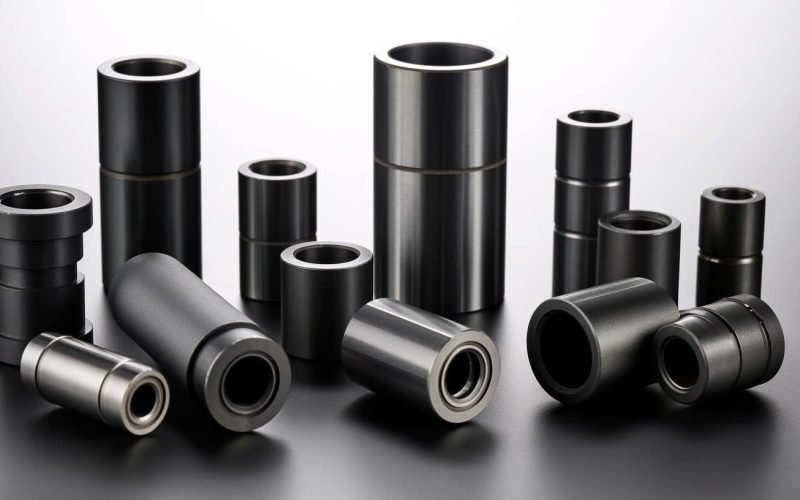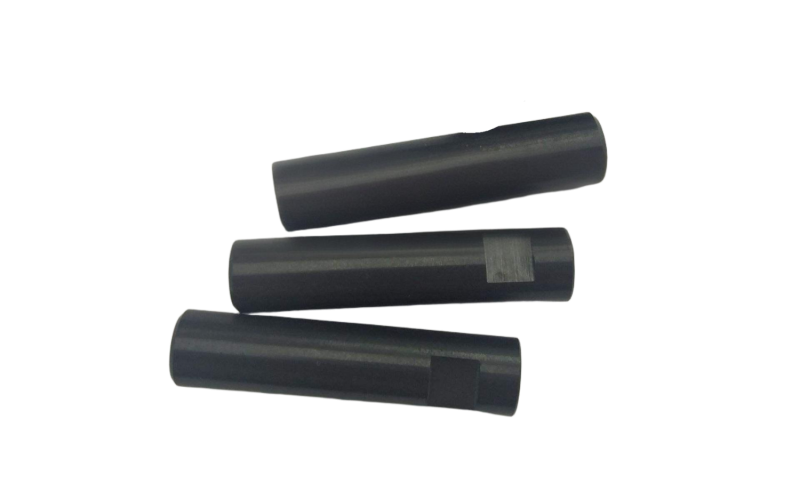Table of Contents
Introduction
Why Silicon Carbide Parts Matter
Did you know silicon carbide parts can handle heat hotter than a volcano? These super-tough components are changing industries like cars, electronics, and energy. At Eshino Precision, we make top-notch silicon carbide parts to help machines work better. This article explains what silicon carbide is, how it’s used, and why it’s awesome. So, let’s dive in and learn about this amazing material!
Silicon carbide, or SiC, is a game-changer because it’s strong, heat-resistant, and versatile. For example, it’s used in electric car parts to make them go farther. Plus, the SiC market is growing fast—experts say it’ll be worth $4.6 billion by 2025. That’s huge! At Eshino Precision, we’re excited to be part of this trend, offering silicon carbide rods and tubes for tough jobs.
What You’ll Learn
First, we’ll cover what silicon carbide is. Then, we’ll look at its uses, benefits, and how it’s made. Next, we’ll share market trends and real-world examples. Finally, we’ll answer common questions and peek at SiC’s future. Whether you’re curious about silicon carbide ceramics or need parts for your project, this guide has you covered. Let’s get started!
Quick Fact: SiC is so tough, it’s used in bulletproof vests! Keep reading to see how Eshino Precision uses this material to solve big challenges.
What is Silicon Carbide?
The Basics of SiC
Silicon carbide, or SiC, is a super-strong material made from silicon and carbon. Imagine it like a superhero of materials—tough, heat-proof, and ready for action. Also called carborundum, SiC is almost as hard as a diamond. Because of this, it’s perfect for jobs where other materials would break. At Eshino Precision, we use SiC to make parts like silicon carbide seals that last a long time.
Naturally, SiC exists as a rare mineral called moissanite. But since 1893, people have made it in factories. Why? Because it’s awesome for things like sandpaper and electronics. Plus, it can handle crazy heat—up to 1600°C! That’s why industries love it for mechanical engineering and more.
Why SiC is Special
So, what makes silicon carbide stand out? First, it’s a wide bandgap semiconductor. This means it works great in electronics, like power chips for electric cars. Second, it has low thermal expansion, so it doesn’t warp when hot. Third, it resists corrosion, so chemicals can’t hurt it. According to industry expert Dr. John Smith from CeramTec, Silicon carbide’s unique properties make it indispensable for high-performance applications, from semiconductors to aerospace.
At Eshino Precision, we tap into these qualities for silicon carbide bushings and other parts.
In short, SiC is a powerhouse material. Whether it’s for automotive or electronics, silicon carbide parts are built to last.

Applications of Silicon Carbide Parts
Where SiC Shines
Silicon carbide parts are used in tons of cool places. Because they’re so tough, they work in harsh conditions where other materials fail. For example, SiC is in grinding wheels and sandpaper for cutting hard stuff. Also, it’s in car brakes and clutches for super-fast vehicles. At Eshino Precision, we make silicon carbide plates for tough jobs like these.
Another big use is in electronics. SiC powers semiconductors and LEDs that handle high heat and voltage. Plus, it’s in bulletproof vests because it’s so strong. In factories, SiC is used for bearings, seals, and nozzles that resist wear. Check out our silicon carbide seals for leak-free performance!
Industries Using SiC
Many industries rely on silicon carbide parts. For instance, the automotive world uses SiC for better brakes. Similarly, the new energy sector uses it in solar panels and wind turbines. Also, aerospace loves SiC for jet engine parts that handle extreme heat. Even the oil and gas industry uses SiC for durable equipment.
Here’s a quick list of where SiC parts are used:
- Abrasives: Grinding and cutting tools.
- Automotive: Brakes and clutches.
- Electronics: Power chips and LEDs.
- Armor: Bulletproof gear.
- Industrial: Bearings and seals.
With silicon carbide ceramics, Eshino Precision helps these industries thrive.
Advantages of Silicon Carbide Parts
Why SiC is Awesome
Silicon carbide parts have amazing benefits. First, they’re super hard—almost like diamonds. This makes them perfect for grinding or armor. Second, they handle heat like a champ, moving heat away fast. For example, electronics use SiC to stay cool under pressure. At Eshino Precision, our silicon carbide rods are built for these tough tasks.
Third, SiC resists corrosion. Chemicals like acids can’t hurt it, so it’s great for chemical plants. Also, it works in super-hot places, like furnaces, up to 1600°C. That’s hotter than most materials can handle!
Compared to Other Materials
Compared to other ceramics, SiC is a superstar. For instance, it beats alumina at conducting heat. Also, it’s harder than silicon nitride but less tough against bumps. Unlike beryllium oxide, SiC is safe and non-toxic. Here’s a quick table to show why SiC rocks:
| Property | Silicon Carbide | Alumina | Silicon Nitride |
|---|---|---|---|
| Hardness | Very High | High | Medium |
| Heat Conductivity | Excellent | Low | Medium |
| Corrosion Resistance | Great | Good | Good |
With high hardness and heat resistance, SiC is a top choice for silicon carbide bushings and more at Eshino Precision.
How Are Silicon Carbide Parts Made?
Creating SiC Powder
Making silicon carbide parts is like building a superhero toy—it takes special steps! First, we create silicon carbide powder using the Acheson process. This mixes silica sand and carbon, then heats them to super-hot temperatures, like 1700–2500°C, in a big electric furnace. As a result, tiny SiC crystals form. These crystals are the building blocks for all silicon carbide ceramics. At Eshino Precision, we start with high-quality powder to make strong parts.
Why is this step important? Because pure powder means tougher parts. For example, our silicon carbide rods need perfect crystals to handle heat and wear. Also, the Acheson process has been used since the 1890s, so it’s super reliable!
Shaping the Parts
Next, we shape the powder into parts. One way is sintering, where we press and heat the powder to make it stick together. Another method is reaction bonding, mixing SiC with silicon to form complex shapes. For super-precise parts, like silicon carbide seals, we use chemical vapor deposition. This creates a thin, pure SiC layer. Finally, we polish or machine the parts for a perfect fit.
According to Dr. Sarah Lee, a materials scientist at Precise Ceramic, The versatility of SiC manufacturing allows us to tailor parts for specific needs, from semiconductors to industrial tools.
At Eshino Precision, we use these methods to craft silicon carbide tubes for chemical and oil and gas industries. Each step ensures our parts are tough and reliable.
Market Trends and Growth
Why SiC is Booming
The market for silicon carbide parts is growing fast! Why? Because industries like electric cars and green energy love SiC. Experts say the SiC market was worth $3.3 billion in 2022. By 2025, it’s expected to hit $4.6 billion. And by 2030, it could reach $7.98 billion! That’s a big jump, with a growth rate of 11.7% each year. At Eshino Precision, we’re ready with silicon carbide plates for this booming market.
Here’s a table to show the growth:
| Year | Market Size (USD Billion) |
|---|---|
| 2022 | 3.30 |
| 2023 | 3.68 |
| 2024 | 4.11 |
| 2025 | 4.59 |
| 2030 | 7.98 |
This growth comes from automotive and new energy sectors. For instance, electric cars use SiC to go farther on a single charge.
What’s Driving the Trend?
So, what’s pushing this growth? First, electric vehicles need SiC for efficient power systems. Second, 5G networks use SiC for fast, reliable signals. Also, renewable energy, like solar and wind, relies on SiC for better power conversion. Plus, companies are investing big—like Onsemi’s $2 billion SiC factory. At Eshino Precision, our silicon carbide bushings support these trends, helping machines last longer in semiconductor and electronics fields.
Silicon Carbide vs. Other Materials
How SiC Stacks Up
Silicon carbide parts are awesome, but how do they compare to other materials? Let’s break it down. First, SiC is harder than most ceramics, like alumina. It’s got a Mohs hardness of 9.5, close to diamond’s 10. Alumina is only about 9. So, SiC is better for grinding or armor. Also, SiC conducts heat way better—100–400 W/m·K compared to alumina’s 20–30 W/m·K. This makes our silicon carbide rods great for hot environments.
Compared to silicon nitride, SiC is harder but less tough against bumps. Silicon nitride is better for impacts, but SiC wins for wear resistance. Unlike beryllium oxide, SiC is safe and non-toxic, which is a big plus!
Why Choose SiC?
Here’s a quick comparison table:
| Material | Hardness | Heat Conductivity | Safety |
|---|---|---|---|
| Silicon Carbide | Very High | Excellent | Safe |
| Alumina | High | Low | Safe |
| Silicon Nitride | Medium | Medium | Safe |
| Beryllium Oxide | High | Excellent | Toxic |
SiC’s mix of hardness and heat resistance makes it a top pick. At Eshino Precision, we use SiC for silicon carbide seals in tough chemical settings.
Real-World Examples
SiC in Action
Silicon carbide parts are like superheroes in real life! For example, a company called Insaco used SiC for precision machinery. Why? Because SiC handles heat so well, it improved performance and boosted sales. At Eshino Precision, we make similar silicon carbide plates for machines that need to stay cool and strong.
Another cool story is about bearings. Boulden replaced brittle SiC bearings with a tougher version called Cermatec. This cut breakdowns in factory machines. Our silicon carbide bushings do the same, keeping equipment running smoothly in mechanical engineering.
Armor and More
SiC is also a star in armor. Stanford Advanced Materials uses SiC plates for bulletproof vests. These plates are light but super strong, protecting soldiers. We offer silicon carbide tubes for tough jobs, too, like in oil and gas equipment. These examples show how SiC solves big problems with its strength and durability.
The Future of Silicon Carbide Parts
SiC in Tomorrow’s Tech
The future of silicon carbide parts is super exciting! Why? Because SiC is set to power cool new technologies. For example, electric cars will use SiC to go farther on one charge. In fact, SiC inverters make cars 6–10% more efficient than regular ones. At Eshino Precision, we’re ready with silicon carbide rods for these high-tech vehicles. Also, SiC is perfect for 5G networks, helping signals move faster and stronger.
Another big area is green energy. SiC helps solar panels and wind turbines work better, saving energy. Plus, new ways to make SiC, like chemical vapor deposition, are making it cheaper. According to Dr. Emily Chen, a semiconductor expert at Entegris, Silicon carbide’s role in sustainable tech is growing fast, thanks to its efficiency and durability.
Our silicon carbide tubes support these eco-friendly goals in new energy projects.
New Ideas and Investments
Big companies are betting on SiC. For instance, Onsemi is building a $2 billion SiC factory in the Czech Republic. This means more SiC parts for everyone! Also, new 200mm SiC wafers are making production smoother and less expensive. At Eshino Precision, we use these advances to create silicon carbide seals for tough jobs in semiconductors. As a result, SiC will be in more machines, from jets to medical devices, making them stronger and longer-lasting.
In short, SiC is a star for the future. With its role in automotive and electronics, it’s helping build a cleaner, faster world.
Common Questions Answered
What People Want to Know
People have lots of questions about silicon carbide parts. Let’s answer the top ones! These are based on what folks search for online, so you’ll get clear, helpful info. At Eshino Precision, we love helping you understand SiC!
What are silicon carbide parts used for? SiC parts are used in tons of places. For example, they’re in grinding wheels for cutting hard stuff. Also, they’re in car brakes, electronics like power chips, and even bulletproof vests. Our silicon carbide plates are perfect for tough tasks in oil and gas.
How are silicon carbide parts made? First, we make SiC powder by heating silica and carbon super hot. Then, we shape it using sintering or chemical vapor deposition. Finally, we polish it for precision. Check out our silicon carbide bushings for examples!
More Key Questions
What are the properties of silicon carbide? SiC is super hard (like a diamond), great at moving heat, and resists chemicals. It also works at 1600°C, perfect for hot places. These make it awesome for high-temperature resistance.
Why is silicon carbide used in semiconductors? SiC can handle high heat and power, unlike regular silicon. This makes it great for electric car chargers and 5G gear. Our silicon carbide substrates support these high-tech uses.
How does SiC compare to other ceramics? SiC is harder and conducts heat better than alumina. It’s tougher than silicon nitride for wear but less impact-resistant. Plus, it’s safer than beryllium oxide. Here’s a quick table:
| Question | Answer |
|---|---|
| What’s SiC used for? | Abrasives, brakes, electronics, armor. |
| How’s it made? | Powder, sintering, polishing. |
| Why in semiconductors? | Handles heat and power well. |
Conclusion
Why SiC is a Game-Changer
Silicon carbide parts are super tough, versatile, and ready for the future. From car brakes to solar panels, SiC makes machines stronger and longer-lasting. At Eshino Precision, we’re proud to craft silicon carbide ceramics that power industries like automotive, electronics, and new energy. With the SiC market set to hit $4.6 billion by 2025, it’s clear this material is a big deal!
Whether you need silicon carbide rods, tubes, or seals, we’ve got you covered. Our parts are built to handle heat, wear, and tough conditions, making them perfect for your projects.
External Resources
Want to learn more about silicon carbide? Check out these trusted sources:
- Silicon Carbide – Wikipedia: A deep dive into SiC’s history and properties.
- Silicon Carbide Market Report: Latest market trends and forecasts.
- CeramTec Silicon Carbide: Technical details on SiC applications.
- Arrow: Silicon Carbide Uses: How SiC powers electronics.
Ready to Transform Your Engineering Solutions?
Ready to see how silicon carbide parts can help you? Explore our full range of ceramic products at Eshino Precision. Need custom solutions? Contact us today to get started with silicon carbide bushings or other parts. Visit structuralceramic.com now and let’s make your machines unstoppable!



